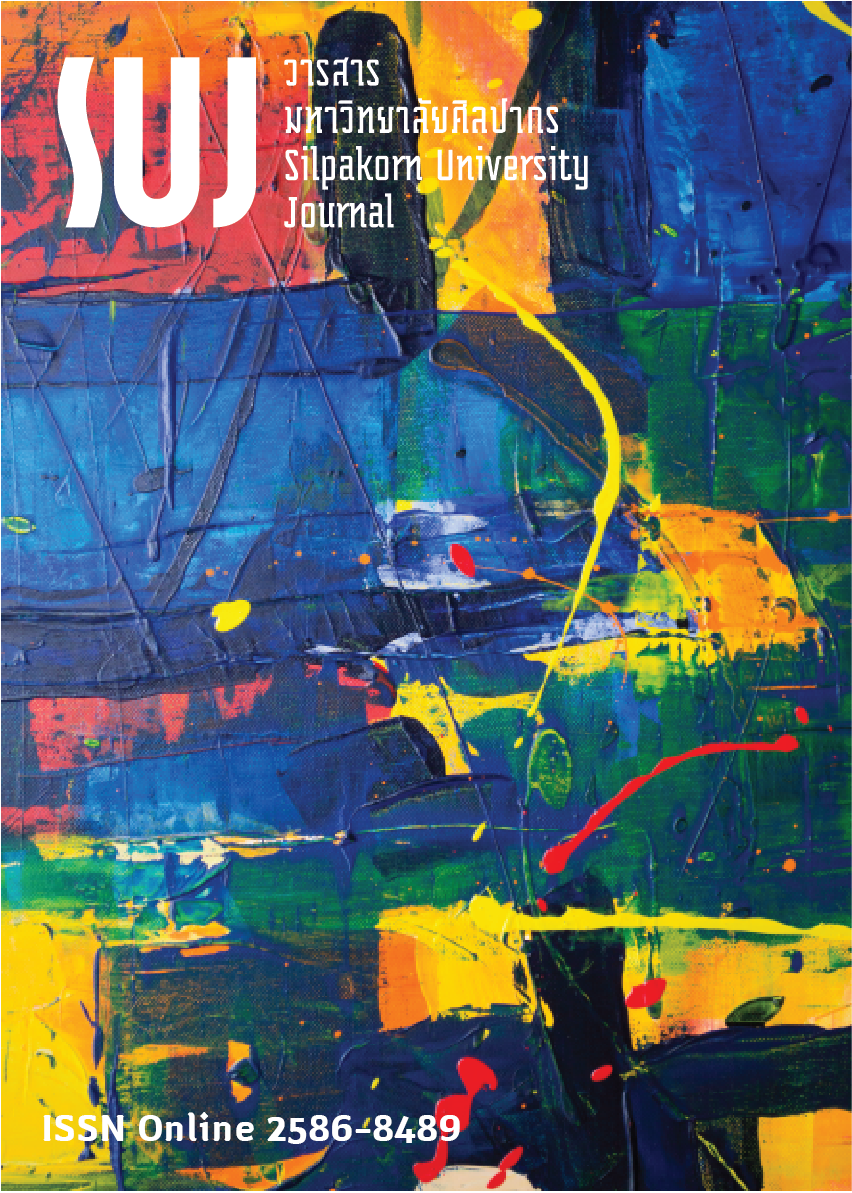การจัดการเรียนรู้แบบสืบเสาะที่ขับเคลื่อนด้วยกลวิธีการโต้แย้ง เพื่อพัฒนาความสามารถในการสร้างคำอธิบายเชิงวิทยาศาสตร์ ของนักเรียนชั้นมัธยมศึกษาปีที่ 4 เรื่อง แรง มวล และกฎการเคลื่อนที่ (Implementing argument-driven inquiry approach for developing grade 10th students’ ability in making scientific explanation in the topic of force, mass, and law of motion)
Main Article Content
Abstract
การวิจัยเชิงปฏิบัติการในชั้นเรียนนี้มีจุดประสงค์เพื่อศึกษาแนวปฏิบัติที่ดีในการจัดการเรียนรู้แบบสืบเสาะที่ขับเคลื่อนด้วยกลวิธีการโต้แย้ง และศึกษาความสามารถในการสร้างคำอธิบายเชิงวิทยาศาสตร์ เรื่อง แรง มวล และกฎการเคลื่อนที่ของนิวตัน กลุ่มที่ศึกษา คือ นักเรียนชั้นมัธยมศึกษาปีที่ 4 จำนวน 29 คน ในโครงการห้องเรียนพิเศษวิทยาศาสตร์ ของโรงเรียนมัธยมศึกษาขนาดใหญ่พิเศษแห่งหนึ่งในกรุงเทพมหานคร เครื่องมือที่ใช้การเก็บรวบรวมข้อมูล ได้แก่ บันทึกหลังการสอนของครู อนุทินของนักเรียน วีดิทัศน์บันทึกการสอน วิเคราะห์ข้อมูลแบบอุปนัย และแบบทดสอบความสามารถในการสร้างคำอธิบายเชิงวิทยาศาสตร์ วิเคราะห์ข้อมูลเชิงเนื้อหา เพื่อจัดกลุ่มคำตอบของนักเรียนรายข้อในแต่ละองค์ประกอบของการสร้างคำอธิบายเชิงวิทยาศาสตร์ จากนั้นหาค่าเฉลี่ยถ่วงน้ำหนัก เพื่อทำการแบ่งอันตรภาคชั้นตามหลักการทางสถิติออกเป็น 3 ระดับ (คะแนนเต็ม 2 คะแนน) ผลการวิจัยพบว่าแนวปฏิบัติที่ดีขั้นที่ 1 การกำหนดประเด็นที่ศึกษา ควรยกตัวอย่างสถานการณ์ที่ท้าทายและเกี่ยวข้องในชีวิตประจำวัน ขั้นที่ 2 การสร้างสรรค์และวิเคราะห์ข้อมูล ควรตั้งคำถามชี้นำในลักษณะคำถามปลายเปิด และเปิดโอกาสให้นักเรียนเป็นผู้สืบเสาะด้วยตนเอง โดยครูเป็นผู้อำนวยความสะดวกแก่นักเรียน ขั้นที่ 3 การสร้างข้อโต้แย้งชั่วคราว รูปแบบของคำอธิบายเชิงวิทยาศาสตร์ควรกำหนดองค์ประกอบอย่างชัดเจน ขั้นที่ 4 กิจกรรมการโต้แย้ง ควรส่งเสริมให้นักเรียนทุกกลุ่มมีส่วนร่วมในกิจกรรมและเน้นให้นักเรียนแสดงความคิดเห็นบนพื้นฐานของตรรกะและเหตุผล ขั้นที่ 5 การเขียนรายงานส่วนบุคคล ควรให้การช่วยเหลือแนะนำให้นักเรียนเข้าใจกรอบแนวคิดของคำอธิบายเชิงวิทยาศาสตร์ และขั้นที่ 6 การอภิปรายสะท้อนผลและการปรับปรุงรายงาน ควรกระตุ้นให้นักเรียนร่วมกันตรวจสอบรายงานของเพื่อนและอภิปรายถึงปัญหาและแนวทางที่เกิดขึ้นระหว่างการทำกิจกรรม และผลจากการวิเคราะห์แบบทดสอบความสามารถในการสร้างคำอธิบายเชิงวิทยาศาสตร์หลังการจัดการเรียนรู้ พบว่าความสามารถในการสร้างคำอธิบายเชิงวิทยาศาสตร์ของนักเรียนเฉลี่ยอยู่ในระดับดี (1.75 คะแนน)
This classroom action research aims to explore the best practices of argument-driven inquiry approach for developing students’ ability in making scientific explanation and to study students’ ability in making scientific explanation on the topic of force, mass and law of motion. The participants were 29 grade 10 students in Enrichment Science Classroom program of a large secondary school in Bangkok. The research instruments were teacher field notes, students’ journals, and video of teacher’s teaching (analyzed via inductive analysis) and the scientific explanation ability test which was analyzed, using content analysis. Then the students’ answers were categorized into groups and the average scores in each component of the scientific explanation were calculated. After that, the overall picture was analyzed by weighted arithmetic mean and the data were grouped into 3 class intervals (Full score=2). The results indicate that the best practice of argument-driven inquiry approach in each step are as follows. 1) For task identification, the teacher should give a challenging situation that is related to students’ daily life. 2) As for the generation and analysis of data, guided questions should be asked in an open-ended format, allowing students to make an inquiry by themselves while the teacher played a facilitator role. 3) In the creating a tentative argument step, each component in the format of scientific explanation should be clearly specified. 4) In the argumentation session, the teacher should encourage all of the students to participate and emphasize that students express opinions based on logic and reasoning. 5) While writing individual report, the teacher should offer students guidelines to ensure their understanding of scientific explanation framework. 6) During reflective and revision of the report, students should be encouraged to revised peers’ report and discuss problems and solutions which arose during the learning activities. After learning through argument-driven inquiry approach, students’ ability to make scientific explanation was at a good level (1.75 points).
Downloads
Article Details
References
Bosse, H. M., Huwendiek, S., Skelin, S., Kirschfink, M., and Nikendei, C. (2010). Interactive film scenes for tutor training in problem-based learning (PBL): dealing with difficult situations. BMC Medical Education. [Online]. Retrieved May 18, 2017 from http://www.biomedcentral.com/1472-6920/10/52
Buaraphan, Khajornsak., & Singh, Penjuntr. (2012). Alternative Conceptions about Force and Motion (แนวคิดคลาดเคลื่อนจากแนวคิดทางวิทยาศาสตร์เกี่ยวกับแรงและการเคลื่อนที่). Kasetsart Educational Review, 22(3): 49-63.
Golding, C. (2011). Educating for Critical Thinking: Thought-encouraging Questions in A Community of Inquiry. Higher Education Research & Development, 30(3): 357-370.
Kemmis, S., & McTaggart, R. (1998). The Action Research. Victoria: Deakin University.
Kuhn, L. & Reiser, B. (2008). Making Sense of Argumentation and Explanation. Science Education, 93(1): 26-55.
McNeill, K. L., Lizotte, D. J., & Krajcik, J. (2005). Identifying Teacher Practices that Support Students’ Explanation in Science. The annual meeting of the American Educational Research Association, Montreal, Canada. (Mimeographed) [Online]. Retrieved May 18, 2017 from https://pdfs.semanticscholar.org/b08b/1469a5a27a46816625d02834777f98a4f87e.pdf
McNeill, K. L., & Krajcik, J. (2007). Scientific Explanations: Characterizing and Evaluating the Effects of Teachers’ Instructional Practices on Student Learning. Journal of research in science teaching, 40(1): 53-78.
McNeill, K. L., & Krajcik, J. S. (2008). Assessing Middle School Students’ Content Knowledge and Reasoning through Written Scientific Explanations. [Online]. Retrieved April 6, 2016 from http://www-personal.umich.edu/~krajcik/McNeilll&Krajcik_NSTA.pdf
Partnership for 21st century skills. (2008). 21st century skills Education and Competitiveness A RESOURCE AND POLICY GUIDE. [Online]. Retrieved April 29, 2016 from
http://www.p21.org/storage/documents/21st_century_skills_education_and_competitiveness_ guide.pdf
Sampson, V., & Gleim, L. (2009). Argument-Driven Inquiry to Promote the Understanding of Important Concepts & Practices in Biology. The American Biology Teacher, 71(8): 465-472.
Sampson, V., Enderle, P., Grooms, J., & Witte, S. (2013). Writing to Learn by Learning to Write During the School Science Laboratory: Helping Middle and High School Students Develop Argumentative Writing Skills as They Learn Core Ideas. Science Education, 97(5): 643-670.
The Institute for the Promotion of Teaching Science and Technology. (2014). PISA 2012 Result, Mathematics, Reading, and Science what do students know? What can be done ? (ผลการประเมิน PISA 2012 คณิตศาสตร์ การอ่าน และวิทยาศาสตร์ นักเรียนรู้อะไร และทำอะไรได้บ้าง). Bangkok: The Institute for the Promotion of Teaching Science and Technology.
White, B. Y., & Frederiksen, J. R. (1998). Inquiry, Modeling, and Metacognition: Making Science Accessible to All Students. Cognition and Instruction, 16(1): 3-118.
Yeo, J., & Gilbert, J. K. (2014). Constructing a Scientific Explanation - A Narrative Account. International Journal of Science Education, 36(11): 1902-1935.


